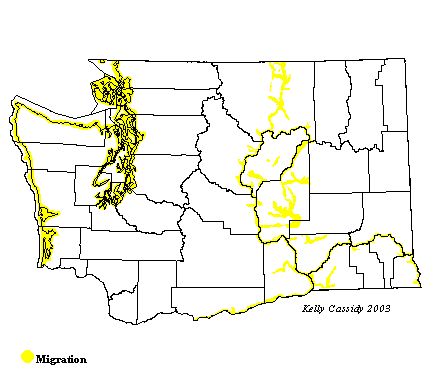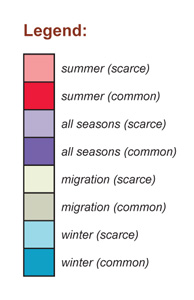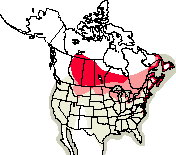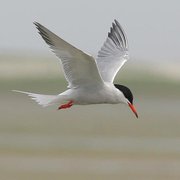Common Tern
The Washington representatives of this family can be split into two groups, or subfamilies. The adaptable gulls are the most familiar. Sociable in all seasons, they are mainly coastal, but a number of species also nest inland. Many—but not all—are found around people. Gulls have highly variable foraging techniques and diets. Terns forage in flight, swooping to catch fish or insects. They dive headfirst into the water for fish. Although they are likely to be near water, they spend less time swimming than gulls.
General Description
The Common Tern is a streamlined bird with narrow, pointed wings. The tail extends beyond the wingtips when the bird is perched. In breeding plumage, the Common Tern has a light gray mantle and belly, a white tail, a white face, and a black cap. Unlike many larger terns, the Common Tern does not have a crest. The bill is bright red with a dark tip (the dark tip is often gone by July), and the legs are red. In the non-breeding season, this tern has black legs, a black bill, and a white forehead. A bold, dark bar is visible on the wrist of first-year birds. The outer wing feathers are dark. Juveniles are brownish with orange bills and legs. As they age, they lose the brown wash and look like non-breeding-plumage adults.
Habitat
Common Terns frequent lakes, rivers, oceans, bays, and beaches. During the summer, they use a wide range of coastal and inland aquatic breeding habitats, but most are found in lowlands, with undisturbed flat islands or beaches surrounded by shallow water. In winter, they are more restricted to warm water coastlines.
Behavior
The Common Tern forages in flight, flying over the water, hovering, and dropping out of the air to catch prey below the surface. They also occasionally steal food from other terns.
Diet
Small fish are the mainstay of the Common Tern's diet, along with insects, crustaceans, and other aquatic creatures.
Nesting
Breeding starts at 3 to 4 years. Most nesting takes place in colonies, but some isolated pairs will breed as well. Both sexes help to make a shallow scrape in soil or sand, which they line with vegetation and other debris. Incubation of the 1 to 3 eggs lasts for about 3 weeks. After a few days, the young leave the nest, but stay nearby. Both parents help feed the young, which first fly at 3 to 4 weeks of age, but stay with the adults for another couple of months.
Migration Status
After breeding, Common Terns may move short distances north before beginning their southward journey. A few fall migrants may linger in the north until November. Common Terns rarely winter in North America, preferring coasts as far south as Peru and Argentina.
Conservation Status
Some populations, especially those in northeastern North America, have declined recently due to competition and predation from large gulls. Coastal populations have become more and more concentrated into fewer colonies. Some inland populations have also experienced decline.
When and Where to Find in Washington
The closest Common Tern breeding colonies are in Alberta and central Montana. In Washington, this tern is a common migrant in coastal areas in saltwater and sandy-shore habitats in May through early June, and then again from August through October. It is uncommon in freshwater habitats. In eastern Washington, it is a rare spring migrant and fairly common in small numbers in fall.
 Abundance
Abundance
| Ecoregion | Jan | Feb | Mar | Apr | May | Jun | Jul | Aug | Sep | Oct | Nov | Dec |
|---|---|---|---|---|---|---|---|---|---|---|---|---|
| Oceanic | ||||||||||||
| Pacific Northwest Coast | U | C | R | F | F | U | ||||||
| Puget Trough | R | R | F | C | U | |||||||
| North Cascades | ||||||||||||
| West Cascades | U | U | R | |||||||||
| East Cascades | ||||||||||||
| Okanogan | R | |||||||||||
| Canadian Rockies | ||||||||||||
| Blue Mountains | ||||||||||||
| Columbia Plateau | U | F | R |
Washington Range Map

North American Range Map


Family Members
 Laughing GullLarus atricilla
Laughing GullLarus atricilla Franklin's GullLarus pipixcan
Franklin's GullLarus pipixcan Little GullLarus minutus
Little GullLarus minutus Black-headed GullLarus ridibundus
Black-headed GullLarus ridibundus Bonaparte's GullLarus philadelphia
Bonaparte's GullLarus philadelphia Heermann's GullLarus heermanni
Heermann's GullLarus heermanni Black-tailed GullLarus crassirostris
Black-tailed GullLarus crassirostris Short-billed GullLarus canus
Short-billed GullLarus canus Ring-billed GullLarus delawarensis
Ring-billed GullLarus delawarensis California GullLarus californicus
California GullLarus californicus Herring GullLarus argentatus
Herring GullLarus argentatus Thayer's GullLarus thayeri
Thayer's GullLarus thayeri Iceland GullLarus glaucoides
Iceland GullLarus glaucoides Lesser Black-backed GullLarus fuscus
Lesser Black-backed GullLarus fuscus Slaty-backed GullLarus schistisagus
Slaty-backed GullLarus schistisagus Western GullLarus occidentalis
Western GullLarus occidentalis Glaucous-winged GullLarus glaucescens
Glaucous-winged GullLarus glaucescens Glaucous GullLarus hyperboreus
Glaucous GullLarus hyperboreus Great Black-backed GullLarus marinus
Great Black-backed GullLarus marinus Sabine's GullXema sabini
Sabine's GullXema sabini Black-legged KittiwakeRissa tridactyla
Black-legged KittiwakeRissa tridactyla Red-legged KittiwakeRissa brevirostris
Red-legged KittiwakeRissa brevirostris Ross's GullRhodostethia rosea
Ross's GullRhodostethia rosea Ivory GullPagophila eburnea
Ivory GullPagophila eburnea Least TernSternula antillarum
Least TernSternula antillarum Caspian TernHydroprogne caspia
Caspian TernHydroprogne caspia Black TernChlidonias niger
Black TernChlidonias niger Common TernSterna hirundo
Common TernSterna hirundo Arctic TernSterna paradisaea
Arctic TernSterna paradisaea Forster's TernSterna forsteri
Forster's TernSterna forsteri Elegant TernThalasseus elegans
Elegant TernThalasseus elegans

